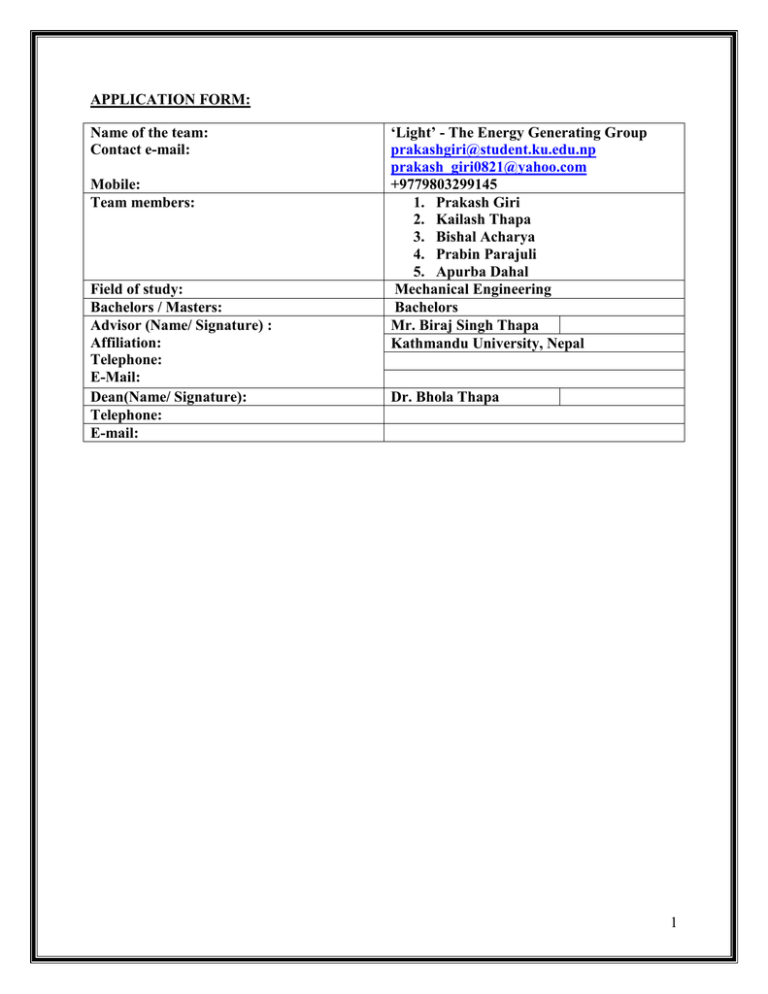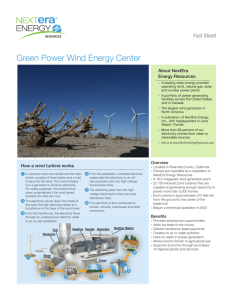APPLICATION FORM: ‘Light’ - The Energy Generating Group Name of the team:
advertisement

APPLICATION FORM: Name of the team: Contact e-mail: Mobile: Team members: Field of study: Bachelors / Masters: Advisor (Name/ Signature) : Affiliation: Telephone: E-Mail: Dean(Name/ Signature): Telephone: E-mail: ‘Light’ - The Energy Generating Group prakashgiri@student.ku.edu.np prakash_giri0821@yahoo.com +9779803299145 1. Prakash Giri 2. Kailash Thapa 3. Bishal Acharya 4. Prabin Parajuli 5. Apurba Dahal Mechanical Engineering Bachelors Mr. Biraj Singh Thapa Kathmandu University, Nepal Dr. Bhola Thapa 1 ‘LIGHT’ – THE ENERGY GENERATING GROUP KATHMANDU UNIVERSITY DHULIKHEL,KAVRE NEPAL Proposal on SMALL SCALE ENERGY GENERATION BY SIMPLE RUNNER (HYDRO-HOME SYSTEM) SUBMITTED BY: ‘LIGHT’- THE ENERGY GENERATING GROUP DEPARTMENT OF MECHANICAL ENGINEERING KATHMANDU UNIVERSITY Date: 10 Apr. 2013 STATEMENT OF PROBLEM: Scenario that motivated us to design and implement the concept of Hydro-home system: Saprubesi is a rural community situated in Langtang area of Nepal and is well renowned for tourism. The area doesn’t have the access to electricity. A local tea shop that provides the facility of telecommunication to the tourists and local community with a cordless telephone was a representative shelter representing nearly 200 houses located at the area. There were three members in the family- A couple with a child. The husband was to look after the tea-shop and the wife was to prepare meal, take the child to the nearest school and then move nearly 3 kilometers downhill, charge the cordless telephone and again climb uphill to her shop. They couldn’t run their shop smoothly in the evening and the child couldn’t study well due to the lack of electric light sources. The wife had to spend nearly 3 hrs. to charge a cordless telephone that was the only means of telecommunication in the entire location. There was a small ever running water cannel just at the side of the shop, which provided our team an inspiration for designing and installing a small model of hydro-home system electricity generator that would be beneficial to help the tea-shop and surrounding locations. 2 PROJECT-PROFILE: Title of Project : Small Scale Energy Generation by Simple Runner (Hydro-Home System) Region of Implementation in Nepal: Saprubesi, Langtang Total Project Cost: NRs. 35,000 (`~= $410) Amount Requested From the Support : In Numbers : NRs. 30,000 (~= $355 ) In Words : Thirty Thousand Rupees Only ( Three Hundred and Forty Dollars ) Primary Sector of Purposed Project : Energy Generation 3 TABLE OF CONTENTS: TITLE 1. 2. 3. 4. PAGE Application Form ………………………………………………………….. 1 Project Profile ……………………………………………………………… 2 Statement of Problem …………………………………………………….... 3 Project Details i. Introduction ………………………………………………... 5 ii. Objectives …………………………………………………... 6 iii. Scope of work ………………………………………………. 7 iv. Expected Outcome …………………………………………. 8 v. Methodology ………………………………………………... 9 vi. Major requirements ……………………………………….. 10 vii. Cost estimated ……………………………………………… 11 viii. Conclusion ………………………………………………….. 12 4 PROJECT DETAILS: i. Introduction: Hydro home system is a power pack i.e. it is a electricity generating unit which consist of pelton turbine coupled directly the dynamic shaft. It is a small project which can generate DC current and have range up to 60-100W. It consists of a pelton turbine, dynamo, a 12V battery, and a continuously flowing water fall with at least 50m of head having discharge of at least 3 m3/s. In this device pelton turbine as well as dynamo is moved by the flow of water from nozzle of the pipe thus ac current is generated which can charge the battery of 12V. Hence the charged battery can be used for various purpose. 5 ii. Objectives: a. Major Objectives: - To produce and provide electricity in small scale to the people of Himalayan as well as hilly region. - To help to run their small business like tea and telephone shop smoothly. b. Minor Objectives: - To help the local community to increase their family income - To show the Multi use of water like in producing electricity and using the same water for drinking purpose. - Work as a member in a team. - Inculcate the qualities of leadership, teamwork, cooperation and coordination. 6 iii. Scope of work: The scope of the Hydro-Home System based project includes the following: - Study of the concept of Hydro-Home System of electricity generation (including pelton runner, generator, dynamo and general fabrication techniques) - Selection of a proper site for the test - Design and product preparation along with implementation in the selected site - Regular monitoring of the system (as per the requirements of the research) - Study of other different locations in which the concept of Hydro -Home System is feasible 7 iv. Expected Outcome: - The rural communities will have the access to electricity and can run their business smoothly - This system will be considerably efficient and might be implemented in all feasible places to enjoy the benefits of electricity 8 v. Methodology and Work Plan: The general work plan and methodology of the project will be as follows: S.N. Tentative Time 1. June 20 – June 25 2. June 25 – July 5 3. July 10 – July 15 T h4. e As per the requirement g e n Work Plan Literature review Product Basic knowledge about Hydro-Home system of electricity generation Design development and Preparation of final improvement product to be installed in the community Field study and Utilization of the water installation of the from a small cannel to product in the society generate electricity Data analysis and Enhancement of general research based study knowledge about electricity generation system and feasibility study of Hydro-Home System 9 vi. Major requirements: PELTON TURBINE: It is an impulse turbine also known as free-jet turbine. It consists of 15-22 bucket in a hub. Water passes through nozzles and strikes spoon-shaped buckets or cups arranged on the periphery of a runner, or wheel, which causes the runner to rotate, producing mechanical energy. The runner is fixed on a shaft, and the rotational motion of the turbine is transmitted by the shaft to a generator. DYNAMO: The dynamo uses rotating coils of wire and magnetic fields to convert mechanical rotation into a pulsing direct electric current through Faraday's law. A dynamo machine consists of a stationary structure, called the stator, which provides a constant magnetic field, and a set of rotating windings called the armature which turn within that field. The motion of the wire within the magnetic field causes the field to push on the electrons in the metal, creating an electric current in the wire. On small machines the constant magnetic field may be provided by one or more permanent magnets; larger machines have the constant magnetic field provided by one or more electromagnets, which are usually called field coils. 10 vii. Cost Estimated: S.N PARTICULARS 1. PELTON TURBINE 2. RATE (NRs.) AMOUNT 01 5000/- 5000/- DYNAMO 01 3000/- 3000/- 3. BATTERY (12V) 01 1500/- 1500/- 4. PIPE 100M 50/- 5000/- 5. NOZZLE 01 250/- 250/- 6. SOCKET 10 50/- 500/- 7. PLUG AND PLAY BALL 01 300/- 300/- 8. LABOUR 05 (3 days) 300/- 4500/- 9. TRANSPORTATION 05 men 1600/- 8000/- 10. MISCELLANEOUS TOTAL QUANTITY 6950/35,000/- 11 viii. Conclusion: Many rural communities of Nepal lack the access to electricity, but most of these communities have good access to plenty of water resources. Thus hydro-home system is designed to serve those rural communities by providing a good access to electricity required for daily activities like studying, media accessing, mobile and telephone charging and so on. This system can be implemented in various locations of Nepal where the access to regular line electricity is denied. Thus this system is believed to be a milestone in the development of rural communities of Nepal and has considerably wide scope. We will commence our project after this proposal is accepted. Based on the principle of survey we will carry out the field work. We hope we can complete this project on time by the team effort and cooperation with our research advisors. 12




